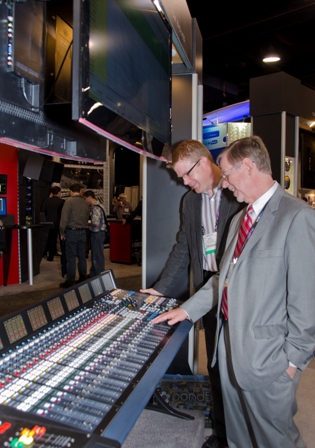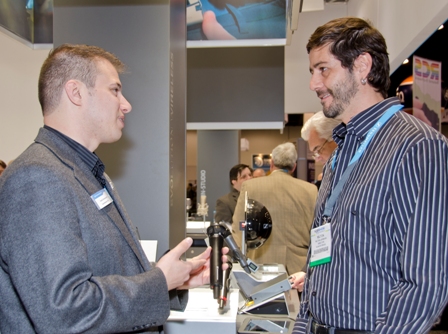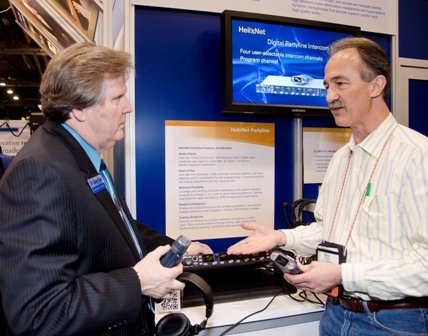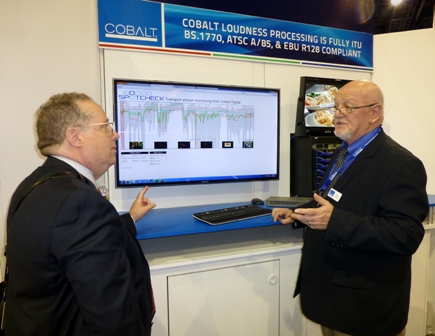Audio at the 2012 NAB Show
As expected, hardware and software tools for CALM Act loudness compliance were at the fore at this year’s NAB Show. But the audio buzzword of the show was MADI: the AES10 standard, introduced in 1991 and updated in 2003, has become increasingly popular in broadcast audio products over recent years.
AUDIO MIXERS
Azden debuted a new and improved FMX-32a, a 3-input, all metal, battery-operated mixer that can be attached directly to the camera. The company also introduced the Azden FMX-DSLR, which includes 2 XLR microphone inputs with individual level controls and switchable phantom power, plus AGC.

Henry Goodman (R) demonstrates the new features of Calrec Audio's Apollo console to Rafael Rodriguez with Respuesta Integral.
Calrec launched the Artemis Light console, which incorporates Bluefin2 high-density signal processing and Hydra2 networking technologies in the same compact scalable control surface used by Artemis Shine and Beam. The company also spotlighted the Apollo audio console, which also relies on Bluefin2 DSP system.
Fairlight announced new options for its flagship EVO series of post consoles, including ergonomic improvements and modifications allowing greater user installation customization. New v4 software for Fairlight’s Dream range adds a host of audio and video handling features.
The NAB Show marked the world premiere of Lawo’s new SDI-Dock, which incorporates eight high-quality embedders and de-embedders plus 128 audio channels connected through MADI. Lawo also demonstrated Ravenna Audio over IP technology and introduced the Ravenna HD Core Card, Ravenna Dallis Master Card, and 8-channel Ravenna I/O modules.
Logitek demoed the JetNet Retrofit Kit, which allows AE-32 Audio Engine owners to convert the existing TDM system to the AoIP JetNet networking system. The kit is compatible with all V3 Audio Engines.
The professional video industry's #1 source for news, trends and product and tech information. Sign up below.
At the Solid State Logic booth the company bowed v5 software for its C100 HDS digital broadcast console, offering a new dual operator mode with inde-pendent physical controls and access to shared audio assets.

Rob Lewis (L) talks about the new Studer Vista 1 audio console with Robert Kupillas (C) and Gary Snyder from Clark Media.
Studer’s new Vista 1 Compact console integrates the control surface, I/O connections and a 96-channel DSP engine in a single chassis, with 32- or 22-fader model options. Studer also introduced its Compact Remote Bay, a portable controller containing 12 motorized P&G faders and 40 rotary controls linked to a touch screen running Studer’s Virtual Vista software. The company also debuted its D21m interface card with Livewire AoIP implementation, as well as integration of the EMBER protocol. Both may be added to Vista and OnAir consoles.
Thinklogical introduced Virtuoso-PRO, offered as a standalone that can send eight audio signals up to 40 kilometers, or in a modular 1RU unit that can support video, KVM and multi-format audio (up to 192 kHz) in the same chassis.
Wheatstone launched the MADI BLADE, a WheatNet-IP system can exchange 64 channels of bidirectional audio with non-Wheatstone networks, consoles, and audio transport devices. Also new from the company was AirAura 2.0, which brings a major upgrade to Wheatstone’s flagship audio processor, enhancing the Vorsis Bass Management System and adding SpeechSmart. Wheatstone also debuted SideBoard, now available in a rackmount form factor, offering the same functionality as its desktop counterpart in just 4RU. The D-8EX is Wheatstone’s D-8 television audio console with layered faders, allowing each physical motorized fader to control two inputs.
Yamaha Commercial Audio Systems launched the new CL Series of digital consoles, available in three sizes and handling up to 256 channels via optional remote I/O boxes and the Dante digital network. The MY8-LAKE card also made its debut, adding Lake Processing features such as Mesa EQ, Ideal Graphic EQ, Linear-Phase Crossover, and other DSP to Yamaha’s digital mixing products.

Phil Owens (R) shows the Wheatstone Dimension One television audio console to Mark Johnson from WAVY-TV.
AUDIO DISTRIBUTION, ROUTING & CODECS
Calrec Audio demonstrated the ability of its Hydra2 audio routing system to interact with third-party control and production automation equipment via Ross Overdrive, SW-P-08 and EMBER protocols.
Cobalt Digital launched the 9374-EMDE Quad Stream SDI–AES–MADI series of embedder/de-embedder processing cards, allowing unrestricted routing between up to four SDI steams, discrete AES-3id and AES10 MADI interfaces.
Lawo showed the all-new Nova29 compact 16-port MADI router with signal routing for 1024x1024 signals, an integral intercom function and other features.
Riedel Communications launched new features for MediorNet’s MN-HDP-6-IO media card, offering up, down and cross conversion, including ARC, for multi-rate 3G/HD/SD-SDI signals. Riedel also presented its new Smart Rack Modular Accessories Suite of fiber installation solutions.
Stagetec introduced a new Dante interface board for the company’s Nexus network system, supporting up to 64 bi-directional audio channels with different sampling rates.
MICROPHONES
AKG relaunched the Project Studio Line, including the C4500 BC for on-air broadcast use, and the C2000, C3000 and C4000 for stage or studio. AKG also unveiled additions to its professional headset line, the HSC 171 and HSC 271 condenser microphone and HSD 171 and HSD 271 dynamic mic models.
Audio-Technica introduced LE/Anniversary limited edition versions of its ATH-M50, AE4100, AE5400, AE6100 and AT4050 microphones featuring a distinct 50th Anniversary design and color scheme. A-T also chose its 50th anniversary to bring back a special edition of the classic ATM25 hypercardioid dynamic instrument mic.
Azden introduced its SGM-3416 and 3416L shotgun electret condenser microphones, which require 11–52 VDC external phantom power.
DPA Microphones launched its handheld d:facto supercardioid vocal mic, offering extreme SPL handling and gain before feedback. DPA’s new d:vote range of instrument microphones build on the success of its 4099 instrument clip mic series, with enhanced the shock mounting.

Robb Blumenreder (L) from Sennheiser shows the new Neumann KK204/205 capsules for the 2000 series wireless microphones to Milton Lehmann from Quanta Brasil.
Neumann’s new KK 204 and KK 205 capsules may be used with Sennheiser’s 2000 Series, creating wireless versions of its KMS 104 and 105 wired hand-held mics.
Shure Inc. unveiled its first full line of dynamic cardioid broadcast headsets, the BRH31M, BRH440M and BRH441M, encompassing single- and dual-sided model options.
WIRELESS
The new Lectrosonics WM Watertight Transmitter is a Digital Hybrid Wireless system combining cabled mic performance with a housing intended to withstand the harshest environments.
Sennheiser added the SKP 300 G3 plug-on transmitter to its evolution wireless ew 300 G3 series, converting any conventional cabled mic into an RF ver-sion. Sennheiser now provides media control protocol for its wireless systems via new V1.7.0 firmware, allowing integration with Crestron and AMX con-trollers.
Shure debuted FP Wireless, a new receiver and plug-in transmitter system for videographers, EFP and other broadcast and media production applications. Shure is now shipping the UR3 plug-on transmitter, a complement to its UHF-R wireless systems.
INTERCOM
Barix AG launched the Annuncicom PS1 Paging Station, which doubles as an IP paging and intercom device. A push-to-talk button allows technical direc-tors to facilitate camera movements and communicate with production personnel while remaining mobile.

David Fry (R) with Omega Broadcast Group asks Michael Rucker about some of the features of the Clear-Com HelixNet Partyline intercom.
Clear-Com introduced the Tempest2400 MasterBelt digital wireless (2.4 GHz) intercom, bringing the features of its Tempest2400 rack-mount BaseStation to a belt pack system. The company also showcased its HelixNet Partyline Intercom System, which will initially consist of the HMS-4X Main Station, HBP-2X HelixNet Beltpack, HLI-2W2 Two-wire Interface Module and the HLI-4W2 Four-wire Interface Module.
JK Audio launched the Interloop Wired/ Wireless Intercom Belt Pack, which combines Bluetooth Wireless Technology with Two-Wire Intercom in a rugged new belt pack design.
RTS/Telex/Electro-Voice debuted the VLink (Virtual Linked Intercom) system, a new, fully interconnected, DHCP-compliant virtual communications solution for RTS intercom systems. VLink enables remote users to interface with RTS matrix intercoms via the Internet using a simple PC-based application.
AUDIO PROCESSING
Dolby Labs demonstrated enhancements to Dolby Digital Plus that enable delivery of 5.1 at 192 kbps, half the typical data rate, plus descriptive audio for the visually impaired. The integrated volume-leveling option of the Dolby MS11 Multistream Decoder in Dolby Digital Plus helps broadcasters achieve CALM Act compliance. The new Dolby Media Emulator production tool enables broadcasters to optimize how audio mixes will sound on the final transmission and to accurately hit the delivery specification.
DTS Inc. announced Adobe Systems has integrated its audio technology into the upcoming Adobe Encore CS6 software release, enabling users to publish Blu-ray Disc and DVD disc images with 5.1 surround sound.
AUDIO SOFTWARE
Barix AG launched a free iOS app, Reflector, a mobile receiver for the Barix Reflector Service, allowing customers to monitor their audio streams.
Merging Technologies’ Ovation V3.0 includes new features, including 64-bit native Windows 7 support, and new audio gain matrix, automation snapshot and general MIDI command mapping.
Sennheiser’s Easy Control app brings remote control and monitoring to its transmitters and receivers and ADN conference system via iOS, AMX, Crestron and other protocols.
LOUDNESS
Barry Watts (L) of Watts Consulting and Chris Shaw of Cobalt Digital discuss the new Cobalt Digital Spotcheck audio monitoring system. Cobalt Digital showcased LMNTS, which performs automatic loudness processing across many transport streams. Also new was SPOTCHECK, which monitors an IP or ASI MPEG stream at the transit encode point to measure and log all material emanating from facilities in larger operations using mul-ti-program MPEG streams.

DaySequerra showcased its M2DTV mobile TV loudness control, designed to keep DTV audio content intelligible in noisy environments on mobile devices.
Digital Nirvana demonstrated Monitor IQ, a monitoring, logging, loudness monitoring, compliance, and content republishing system for TV networks and stations. It will now be offered in four levels: Starter, Essentials, Plus and Premier.
DK Technologies spotlighted its new DK3 compact audio loudness meter that delivers conventional metering as well as ITU, EBU R128, ARIB and ATSC-compliant loudness metering on a device the size of a smart phone.
Harris has added a new MSA-OPT-LOUD loudness compliance option to its Videotek MSA-100 and MSA-300 Multi-Source Analyzer Series of prod-ucts. Harris also showed a software upgrade prototype integrating its LLM-1770 loudness logger and monitor with Harris ADC automation, providing as-run records of loudness levels for recently aired programming.
Jünger Audio announced that Thomson Video Networks is bringing Jünger’s Level Magic loudness technology to its ViBE encoding platform.

Mike Bollanger (L) of TV Specialist listens to a pitch on the Linear Acoustic AERO.1000 audio loudness platform from Jim Kuzman.Linear Acoustic introduced Aero.1000, comprising up to 8 Aeromax audio processing engines, each with Upmax upmixing, up to 8 Dolby decod-ers/encoders and up to 8 Nielsen Watermark encoders. The Linear Acoustic LQ-1 loudness meter is a straightforward solution for measuring loudness in DTV facilities and supports all current metering standards. The LA-5280 is Linear Acoustic’s Dolby bitstream and metadata encoding and decoding plat-form; Infrastructure Encoder and Transmission Encoder versions are available.
Minnetonka Audio Software showcased its AudioTools Server, which automatically ensures loudness compliance in all A/V formats. The product currently in use at most major European state broadcasters, as well as SBS, STER, Digiturk, Canal +, France Publicite, Ericsson, Visual Data, Sky and Fox.
Miranda Technologies introduced segment-aware loudness monitoring and logging to its Kaleido series multiviewers and the real-time loudness correction processors. Miranda also debuted Intelligent Automatic Loudness Correction, which detects if a file has already been processed or not and turns loudness correction off or on accordingly.
Orban TM7 TouchMonitor will be fully integrated into Calrec’s complete range of digital audio consoles, and will also be available for retrofitting.
The latest firmware, v1.24, for the Qualis Audio Sentinel audio monitor offers several enhancements, including a unique dialog balance measurement and downmix loudness measurement.
The RTW TM7 TouchMonitor will be fully integrated into Calrec’s complete range of digital audio consoles, and will also be available for retrofitting.
Volicon showed a new loudness monitoring module for its Observer platform, with enhanced graphing, reporting and real-time alert features that simplify critical compliance tasks.
Steve Harvey began writing for Pro Sound News and Surround Professional in 2000 and is currently senior content producer for Mix and a contributor to TV Tech. He has worked in the pro audio industry—as a touring musician, in live production, installed sound, and equipment sales and marketing—since November 1980.
